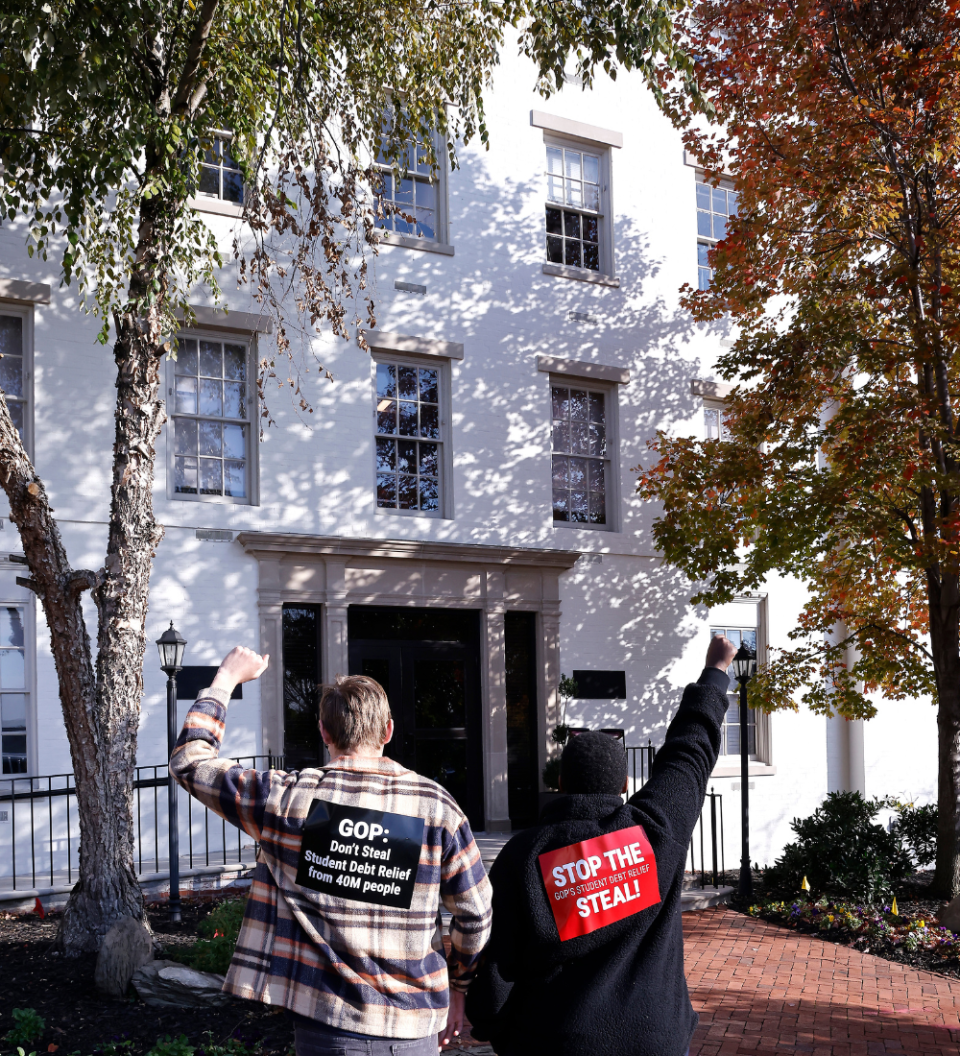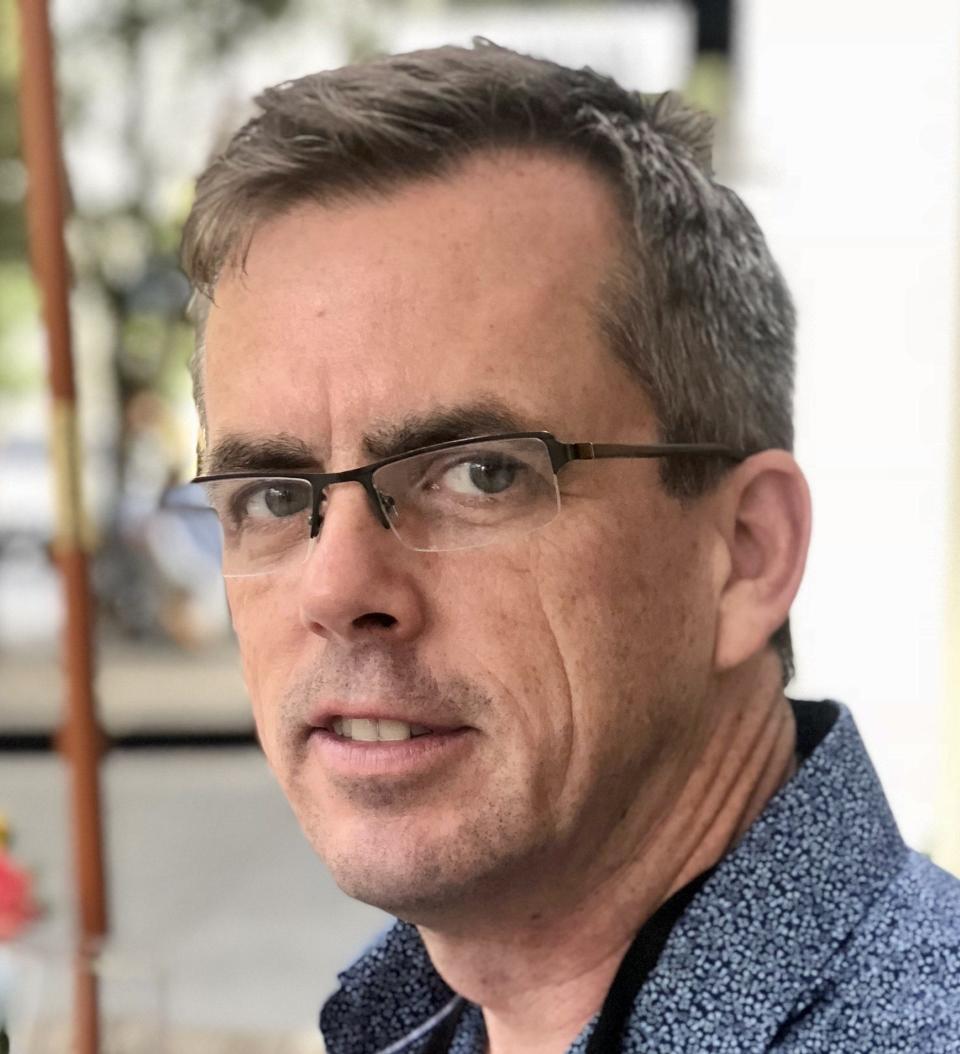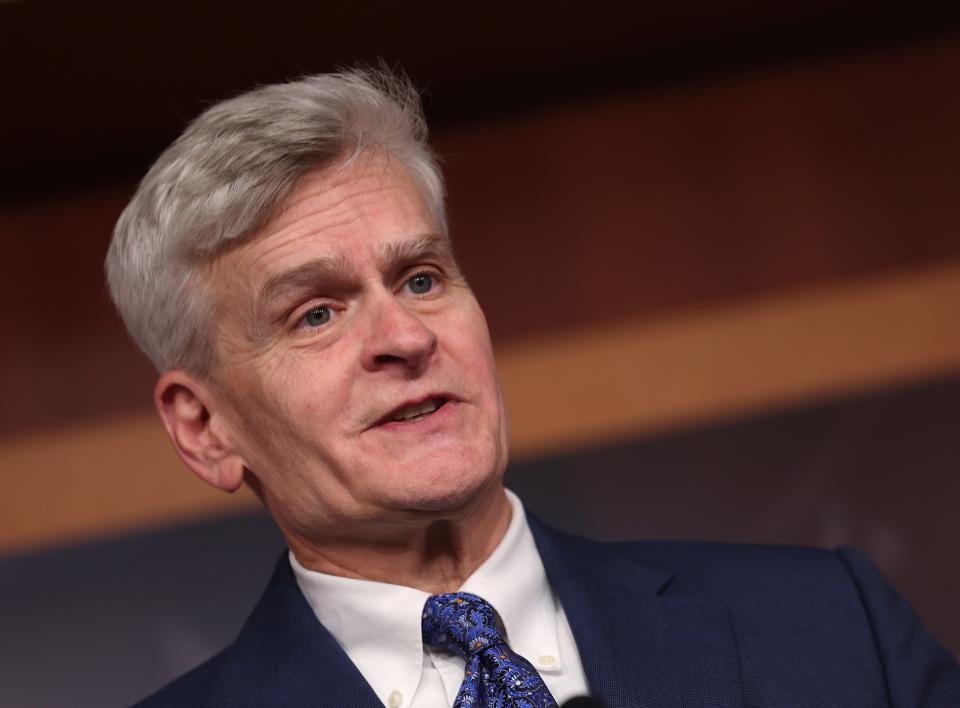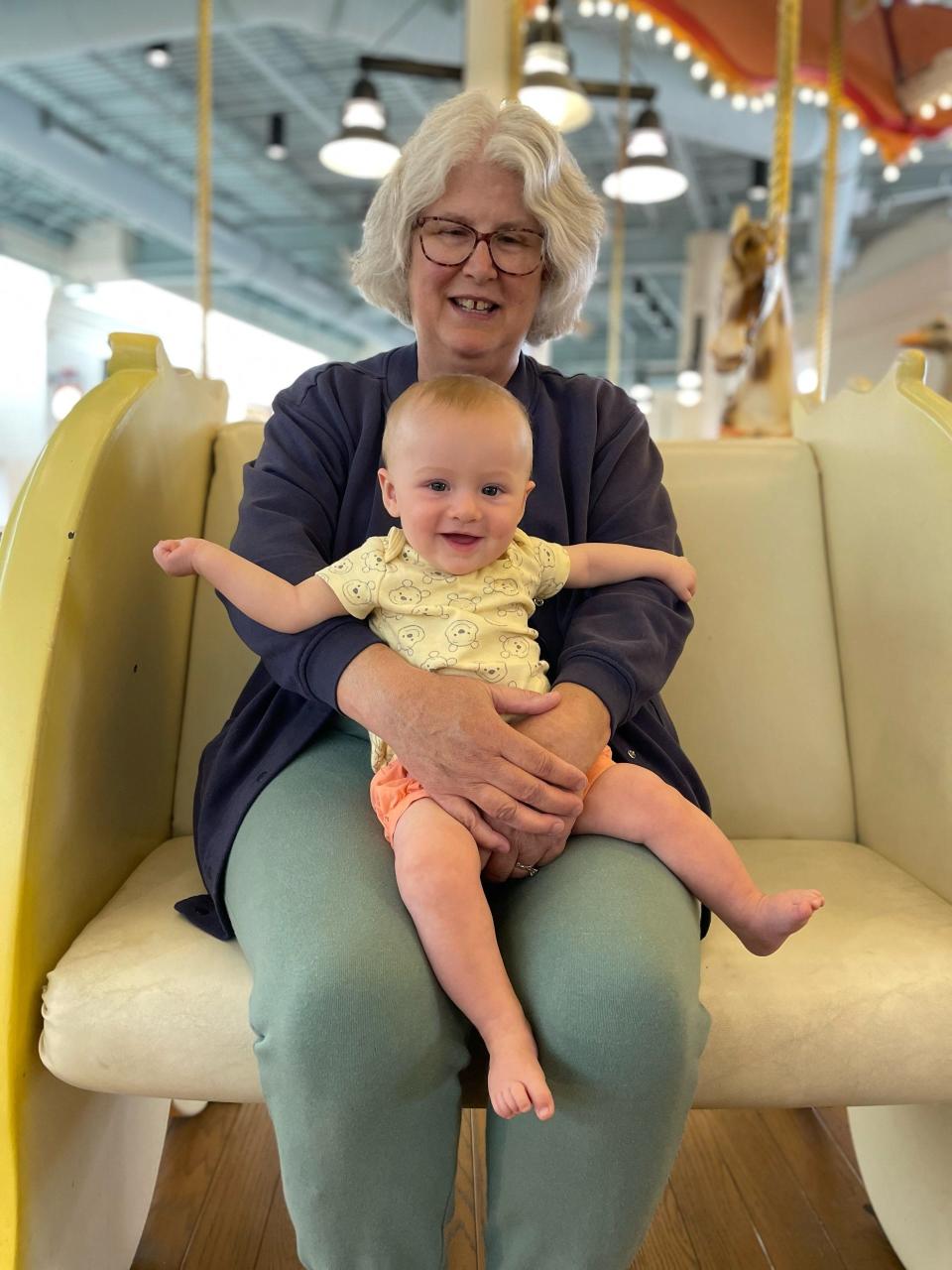Student loan debt forgiveness becomes a reality for more than 804,000 who paid for decades
- Oops!Something went wrong.Please try again later.
A while back, Katrina Mosler set up a barrier around the trash cans outside her rural northern California home. Bears had been invading the bins and tearing through bungee cords meant to keep them shut.
But at about 3 a.m. on a Tuesday in August, she heard a commotion. The motion detector lights outside lit up. A persistent bear wanted to get at the trash despite the enclosure.
Wide awake, Mosler decided to check something before returning to bed. She logged on to her student loan servicer website.
What she saw was a smiley face and a balance of zero.
Mosler, 47, is one of about 804,000 people who found themselves in the same enviable situation this summer. Her outstanding student loan balance, which she had been paying down for roughly 20 years, was gone.

This group of borrowers signed up for what, decades ago, was a new option from the federal government: Making regular payments aligned to their income for 20 or 25 years. When they hit that threshold, the rest of their balance was supposed to be forgiven. A review, however, found that for some of them, years of payments hadn’t added up to an erased balance. The federal Education Department is correcting a miscalculation in the number of payments a legion of borrowers made.
Mosler, of an area called McKinleyville, California, said the $27,000 she owed hung over her life. Now, as one of the 804,000 whose debts have been erased, there’s room to think about saving for a down payment on a house, instead of the rental surrounded by redwoods, and bears, where she lives with her husband.
Others with student loan debt whose balances were cleared report paying what they originally borrowed, or twice that, and still staring down thousands of dollars to repay.
Mosler started college in 1995 at what was then Humboldt State University, taking out student loans to finance a physical therapy degree. But she dropped out two years later and put her loans into forbearance, meaning she didn't make payments but interest accrued. The size of what she thought was a manageable amount of debt ballooned.
“When you drop out, there’s no guidance,” she said. “I was 20 and struggling and just pretty aimless.”
Student loan interest crisis? New bill could eliminate rates for many borrowers
Student loan interest: Never making a dent in the debt
Mosler returned to school a decade after her first go, only to graduate with a degree she realized wouldn’t lead to her dream career as a physical therapist. And while the income-based repayment option allowed her to stay afloat as she worked a low-wage retail job, the interest – combined with confusion over whether her payments counted – made it feel like a balance of zero was moving further and further out of reach. Even when she eventually found success in massage therapy, the debt continued to haunt her.
That relief happened overnight feels surreal for Mosler and many others who got that smiley face. These “golden emails,” as student loan expert and advocate Betsy Mayotte describes them, came after decades of sacrifices made to keep up with the payments. Borrowers including Mosler shared some of their tales of forgiveness on Reddit, on what Mayotte labeled the "Mega-thread for the golden emails."
Their experiences leading up to the erasure of their balances, and the basic expenses they can now afford as a result, show the extent to which the student loan system has affected hundreds of thousands of older low- and middle-income borrowers. Amid debate over who should pay and be accountable for the country’s spiraling student loan crisis are borrowers who lived up to what they signed up for and did as told but still haven't shed their debt.

“They’re promising that you’re going to have it retired in 20 or 25 years,” said Christopher Gaunya, who, at 61, thought he would never be able to buy a home or save enough to retire comfortably.
Then a few weeks ago, Gaunya eagerly refreshed his inbox and there it was – an email notifying him, essentially, that he was off the hook. Off the hook for the nearly $150,000 he owed on $63,000 student loans dating back to the 1980s, an amount that snowballed thanks to interest locked in at more than 8%. Off the hook for debt that at one point had Gaunya contemplating suicide.
“It feels like I can breathe again,” said the acupuncturist, who is based in Massachusetts.
He is one of more than a million people who signed onto a Change.org petition calling on the president to cancel loans and restore borrowers’ bankruptcy rights.
Gaunya completed much of his higher education, including a bachelor's in geography, without borrowing a lot to finance it. A job working for the state helped him keep up with the payments. But in the mid-1990s, he decided to switch careers and study acupuncture. That meant tens of thousands in additional student loans, all for training that he said ultimately failed to teach him what he needed to know to make a living in the field.
Falling ‘through the cracks of a broken system’
Gaunya persevered, getting an acupuncture contract job at a hospital and eventually a full-time gig with the Department of Veterans Affairs. Signing up for income-driven repayment – years after completing acupuncture school and only after he did lots of his own research – allowed him to get his payments under control.

Under income-driven repayment, however, many borrowers’ monthly bills are so low they don’t touch or barely graze the principal. Their debts can mushroom.
That was the case for Mosler, whose loan payments never seemed to reduce her debt. “You look at your bill. Your payment is for $113, and $8 of that goes to the principal. The rest goes to interest. It just feels really defeating.”
The Biden administration had for more than a year been working on an adjustment to recalculate the number of payments some borrowers made, which Education Secretary Miguel Cardona framed as a fix to “past administrative failures.” The outstanding debt of affected borrowers was what remained on their loans after the equivalent of 20 to 25 years’ worth of payments.
“For far too long, borrowers fell through the cracks of a broken system that failed to keep accurate track of their progress toward forgiveness,” Cardona said in a July statement announcing the news.
The 804,000 borrowers whose loans were discharged through the adjustment mark one of the largest groups of former students who’ve seen relief under the Biden administration this year. An additional 1.1 million borrowers have had their debt forgiven through defense to repayment, in which students who were defrauded by their colleges are eligible for relief.
An additional 175,000 borrowers who worked for more than a decade in public service finally got the relief they were promised back when they chose to go into these modestly paying careers.
The wait until 'everything says zero, zero, zero'
When he got the first email notifying him of his prospective relief, Gaunya nearly cried. “I got shaky and welled up and was like, ‘Oh my god, oh my god, oh my god.’” Vibrating with excitement, he forced himself to “not act like this is real.” He wanted to wait until he got the official email, until “everything says zero, zero, zero.”
Like pretty much all of Biden’s efforts to relieve student debt, this one-time adjustment was almost immediately met with a lawsuit. A couple weeks after the adjustment’s announcement, two right-leaning think tanks – the Cato Institute and Mackinac Center for Public Policy – sued the administration, arguing it lacked the authority to forgive the outstanding debt.
But a federal judge quickly dismissed the lawsuit.
Now that it’s reality, Gaunya is allowing himself to celebrate. Even if more lawsuits challenge the adjustment, he’s convinced any relief already doled out will be impossible to recuperate.
The pause is over. As student loan payments resume, how to make sure you're prepared
Student loan debt forgiveness, once an idea limited to progressive circles, moved into the mainstream. Biden, once seen as a centrist Democrat, made it a campaign promise.
Some members of Congress, particularly those on the right, have argued student debt relief is a Band-Aid and that pressure instead ought to be on colleges for reducing tuition costs. Many Americans believe relief for borrowers is a handout at the expense of taxpayer dollars.
“It makes me mad when people are like, ‘I’m a taxpayer. I don’t see why I have to pay for your mistakes,'” said Lisa Frisby, 52. “I’m telling you, I’ve been paying on that student loan.”

When Frisby started college in 1993, she was on her own to finance a degree. She borrowed money to pay for housing, tuition and books, and got a job so she would have health insurance.
A pair of degrees in computer science and management information sciences from her New Jersey university, at first, seemed to pay off. The salary from her first job was enough to cover her rent and make student loan payments.
But 25 years after graduation, the debt wasn’t gone – even though Frisby signed up for an income-driven repayment option and paid consistently for all that time.
Somewhere along the way, she said, a record of some of her payments was lost. There was no proof of nearly a decade’s worth of them.
Fast forward to this year: After about $70,000 worth of payments on a $40,000 loan, the golden email means she’s now finally free.

“I can’t tell you how relieved I am,” said Frisby, who bought the first new car she’s ever owned since her balance was erased. Frisby returned to school to become a nurse, avoiding additional loans by getting help from family to pay tuition and shopping for the cheapest program she could find. She’s actually due a refund because of all the payments she made, and if that money materializes, she said she will pay off all her credit card debt.
“I’ll just have my car and my mortgage,” she said. “I don't need to be rich. I just want to be at zero."
Free to focus on the things that matter
Emmy Yoder, 62, and her husband spent their careers in public service, he in social work, and she in public school teaching. But they never managed to qualify for public service loan forgiveness (PSLF), apparently the result of bureaucratic lapses.
Her husband, who has an autoimmune disease, ended up having his student loan debt forgiven because of his illness. Yoder, unable to secure PSLF, had to sign up for income-driven repayment. Yet relief always felt fleeting, especially with the $40,000 in interest that accrued since she took out her loan in 1997 – not to mention the costs of raising their twins, now 29.
Yoder made payments for more than two decades, though at times had to go into forbearance. “Life isn’t cheap,” said Yoder, who before retiring last year worked at a high-poverty school in Missouri. “Trying to balance it all was so difficult.”
“It was a little embarrassing to admit that I wasn’t able to pay them off, but it wasn’t for lack of trying,” she said, noting she was told twice that she couldn’t get PSLF because her school district wasn’t low-income enough. (PSLF does not have such rules.) “I never did understand how I didn’t qualify for that. It’s such an impossible situation, trying to understand.”

A little over a month ago, she got the initial email explaining she might be eligible for relief through the one-time adjustment. “I’ve never played the lottery; I’ve never won anything in my life,” said Yoder, one of the other signatories on the Change.org petition. “This was amazing.”
While they’re already retired, now Yoder and her husband finally have “a lot of breathing room.” One of her daughters, also a teacher, asked if Yoder can help with child care and now, Yoder feels comfortable saying yes. She doesn’t have to get a part-time job to keep up with her student loan payments.
“Now I can be fully retired and help my daughter, help the next generation.”
If you or someone you know is struggling or in crisis, help is available. Call or text 988 or chat 988lifeline.org
This article originally appeared on USA TODAY: Student loan debt erased for 804K people. Then came tears, disbelief.

